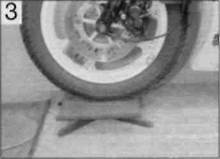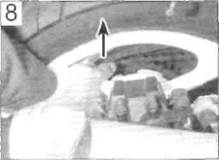
CATEGORIES:
BiologyChemistryConstructionCultureEcologyEconomyElectronicsFinanceGeographyHistoryInformaticsLawMathematicsMechanicsMedicineOtherPedagogyPhilosophyPhysicsPolicyPsychologySociologySportTourism
Steering and Suspension

With the front wheel raised off the ground, rotate the steering from lock to lock. The handlebar or switches must not contact the fuel tank or be close enough to trap the rider's hand. Problems can be caused by damaged lock stops on the lower yoke and frame, or by the fitting of non-standard handlebars.
When performing the lock to lock check, also ensure that the steering moves freely without drag or notchiness. Steering movement can be impaired by poorly routed cables, or by overtight head bearings or worn bearings. The tester will perform a check of the steering head bearing lower race by mounting the front wheel on a surface plate, then performing a lock to
lock check with the weight of the machine on the lower bearing (seeillustration 3). Grasp the fork sliders (lower legs) and attempt to push and pull on the forks (see

Front wheel mounted on a surface plate for steering head bearing lower race check
illustration 4).Any play in the steering head bearings will be felt. Note that in extreme cases, wear of the front fork bushes can be misinterpreted for head bearing play.
Check that the handlebars are securely mounted.
Check that the handlebar grip rubbers are secure. They should by bonded to the bar left end and to the throttle cable pulley on the right end.
Front suspension
With the motorcycle off the stand, hold the front brake on and pump the front forks up and down (see illustration 5).Check that they are adequately damped.

|

|

|
| w w |
- .
Checking the steering head bearings for freeplay
Hold the front brake on and pump the front forks up and down to check operation
MOT Test Checks ref«29

|
Inspect the area around the fork dust seal for oil leakage (arrow)
Bounce the rear of the motorcycle to check rear suspension operation

Date: 2016-01-14; view: 1091
| <== previous page | | | next page ==> |
| Torque (moment of force) | | | Checking for rear suspension linkage play |